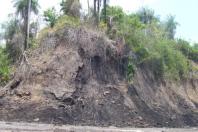Competition for T&T’s tar sands Two companies offer ‘safe’ options
Developers of a Canadian plant that recycles old tyres say that it can be reconfigured to process tar sands without using precious water resources and the chemicals used in the Canadian tar sands mining model which are wreaking havoc on the environment.
Australian Ken Falconer, designer of the plant, said it could be used locally to minimise damage from events such as last December’s oil spills in the south-west peninsula, the fires in the Beetham Landfill. He said the Environment Recovery Solutions Ltd (ERS) pyrolysis plant uses a very simple process where the material is heated at high temperatures in the absence of oxygen in a completely sealed environment. When tar sands are processed through the plant, clean sand comes out one end and oil on the other end, he explained.
“The Canadian tar sands mining method uses steam and chemicals in its extraction process. At best they can take out 80 per cent of the oil with 20 per cent left in the contaminated sand but the waste water and chemical residue is the environmental nightmare. “Our process cleans the sand to a 99.99 per cent ratio that has no organic matter in it and it’s like beach sand.” He said organics added to the it can be used for agricultural purposes, in construction and in sandbags.
Falconer said his partners in ERS are willing to relocate the plant to T&T to process the oil-contaminated sand on the beaches at La Brea affected by Petrotrin’s oil spills. However, the plant cannot recycle the oil that spilled into the sea.
He said ERS wants to ask the Ministry of Energy and Energy Affairs (MEEA) for a trial license to come to Trinidad and construct a small pilot plant which will extract 500 barrels of oil a day from tar sands. Government can let the plant operate for a year, evaluate and test emissions, test the product and if it is not working, shut it down.
All we want is a chance
Gerard Ferreira, former mayor of San Fernando, who is a partner in ERS, said the system offers an opportunity to develop T&T’s natural resources in an environmentally friendly manner. He said it made good business sense to recover one-and-a-half billion barrels of oil at $99 a barrel since it will benefit the economy while preserving the environment
Ferreria said Falconer’s plant design is modular, unlike conventional tar sands processing plants which needed to be as big as Petrotrin’s Pointe-a-Pierre refinery and it can be custom-built to handle smaller scales such as 1,500 barrels of oil. In addition, it can be dismantled and transported with “minimal effort”, freeing up land space and creating more entrepreneurs as 80 per cent of the plant can be manufactured in T&T.
He said the full operating system, which can extract producing 500 barrels of oil a day, will occupy less than five acres of land. Ferreira said the company has applied for its own excavation license in Parry Lands, in Trinidad’s southern peninsula.
Ferreira said successive administrations have acknowledged the economic potential for developing tar sands are cautious about going forward with the concept because the negative fallout from conventional mining and pressure from environmental groups. State-owned Petrotrin was granted a license for tar sands exploration in 2009.
While ERS is still exploring prospects for its enviromentally friendly tar sand mining operations in T&T, another company is closer to getting off the ground. Geologist Herbert Sukhu said his company, Geominex Resources Limited, has signed a memorandum of understanding (MOU) with the Ministry of Trade, Industry and Investment (MTII) for tar sands exploration in the La Brea region.
Sukhu said his company's “small footprint mining” method will use proprietary solvent retort processes which are more environmentally friendly than the Canadian model. He said strip mining could produce between 30,000 to 50,000 barrels of oil per day and entails “stripping certain areas, extracting the usable tar sands and filling back the waste material.” That is not a small scale operation and could eventually end up costing US$5.2 billion, he said.
Falconer said Sukhu's company used similar technology to ERS, but also uses a chemical process to assist the flow of oil. He believes his company has a superior product and is further along in development and implementation of its technology.
Extracting oil from sand
Oil sands are a mixture of sand/clays, bitumen and water. Each grain of oil sand has three layers: a layer of water surrounding the grain of sand, with bitumen surrounding the water to form the outer layer. Oil sands are often referred to as tar sands or bituminous sands. Tar sand deposits are mined utilising techniques such as strip mining, open pit techniques, and underground heating (steam injection) to extract the oil.
The complex process of recovering oil from tar sands involves many steps in order for the oil to be profitably extracted and upgraded to a usable product. The recovery process typically involves the following steps:
• Extracting the oil from the sand
• Separating the bitumen from the clay, sand, and water
• Diluting the bitumen with lighter hydrocarbons to pass through pipes easier
Across Trinidad, exploration conducted several ago estimated some 1.5 to 2 billion barrels of bitumen-based fuel. The southern communities of Vessigny, Guapo, Parrylands, Vance River, and La Brea all exist directly on top of tar sands deposits. Last December, the Ministry of Energy and Energy Affairs established 35 mining zones across T&T, including one provisional mining zone for tar sands.
http://www.guardian.co.tt/news/2014-04-20/competition-tt%E2%80%99s-tar-s...


